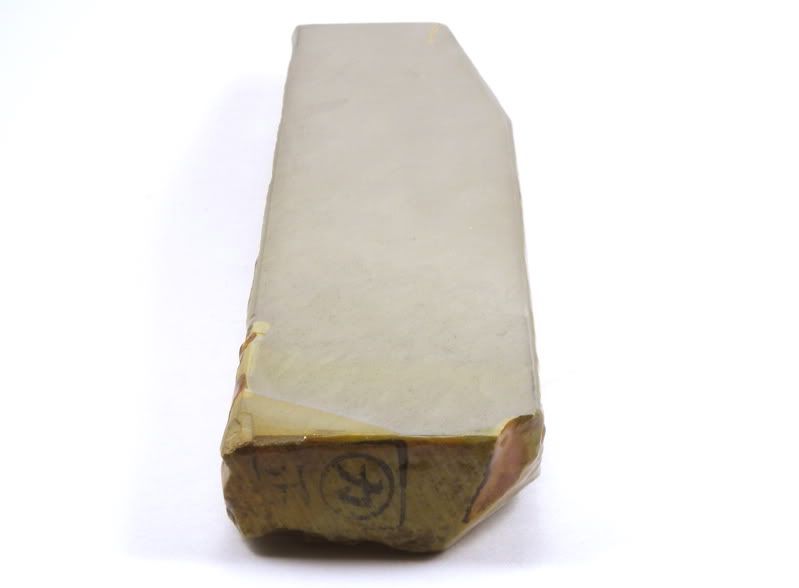Results 31 to 40 of 45
Thread: New Japanese Stone
-
05-02-2010, 12:26 PM #31Member

- Join Date
- Jan 2010
- Posts
- 37
Thanked: 4
As much as I hated to, I lapped the Nakayama. The Kanji is gone, but more importantly, it now improves the edge from the Suita when shaving my arm hair. The real test will be a shave tomorrow.
-
05-02-2010, 01:43 PM #32

Did you take photos before you lapped ? Or if you have the seller's photos save them. That way if you ever decide to sell the stone you've got some documentation. Good luck with the shave.
 Be careful how you treat people on your way up, you may meet them again on your way back down.
Be careful how you treat people on your way up, you may meet them again on your way back down.
-
05-03-2010, 03:33 AM #33

Sorry if this is a thread hijack, but I have a relevant question. Both of you wrote that finding both a Maruichi stamp and a Maruka stamp on the same stone is odd, and this intrigues me. Can you explain further what is odd about it?
The reason I ask is that I also have a stone that has a Maruichi stamp on the surface, and a Maruka stamp on the side at the top end. This stone was my first Japanese natural, and because of this, I always just assumed these two stamps were somehow related and commonly seen together. Your help in understanding this is appreciated.
Here is the actual stone, with the Maruichi and other stamps in place before I lapped it. The second picture (taken in a light box) shows the same stone, lapped and lacquered, with the Maruka stamp on the side at the top end:


Finally, I also have a Kiita that does have a Maruichi stamp on top, but has no Maruka stamp anywhere. Funny, but I got this stone after the Asagi, and thought at the time it was odd that it didn't have a Maruka stamp on the top end like the Asagi did.

-
The Following User Says Thank You to FatboySlim For This Useful Post:
Evritt (01-02-2011)
-
05-03-2010, 04:22 AM #34Member

- Join Date
- Jan 2010
- Posts
- 37
Thanked: 4
I was told that Maruichi got some of its stones from Maruka to sell. Not shure if that is true or not.
-
05-03-2010, 04:23 AM #35Member

- Join Date
- Jan 2010
- Posts
- 37
Thanked: 4
Shaved this morning and the lapping fixed it. Shaves great of the Nakayama now.
-
05-03-2010, 07:23 AM #36
-
The Following User Says Thank You to Bruno For This Useful Post:
FatboySlim (05-03-2010)
-
05-03-2010, 09:08 AM #37Member

- Join Date
- Jan 2010
- Posts
- 37
Thanked: 4
I just looked up the explanation of Maruichi I got a few months back. I was told that Maruka is actually a brand from Maruichi, meaning Maruichi was the bigger company, and Maruka a smaller specialized one. Kind of like Toyota and Lexus (with Maruka being the Lexus).
-
The Following User Says Thank You to joes978 For This Useful Post:
FatboySlim (05-03-2010)
-
05-03-2010, 09:12 AM #38Member

- Join Date
- Jan 2010
- Posts
- 37
Thanked: 4
From Japan-tool.com:
(Maruka) Shou-hon-yama is the best grade stone from Nakayama sold by the sole miner of this mountain, Hatanaka Natural Sharpening Stones Stone Industry. Any (well basically, but there are many that are not so good, so we have to test all of them before selling) Nakayama stone that has this stamp (unless it's a fake) is guaranteed of its highest quality. Maruichi Maruka stones were quarried before the mining was taken over by Hatanaka family, when the owner of the mine was Kato family. Maruka's (= circled "Ka") "Ka" is Kato's first character "Ka".
-
05-04-2010, 12:04 AM #39

Thank you, that explanation kind of makes sense. There's a lot about the family and business relationships around Japanese natural stones that I find pretty baffling, let alone the stones themselves.
In fact, I find the whole natural honing stone mining subject to be shrouded in mystery and lore worldwide. Maybe it's because the operations were all small and highly localized, and natural stones have ceased to be commercially important for nearly 100 years. I'm surprised that there isn't more information (books, company records, trade publications, identification guides) about honing stones and mining out there. Maybe I just don't know where to look. Or maybe this is an even more arcane interest than I thought it was.
Until I started honing straights, I never in my life saw or heard of a honing stone that wasn't an Arkansas stone of some kind. In my mind, "honing stone" or "oil stone" literally meant "Arkansas stone." I guess it never occurred to me back then that people around the world needed to sharpen things, too, and used something other than Arkansas stone. I think maybe I didn't understand that Arkansas stones actually came from Arkansas/Oklahoma, I assumed it was just some sort of nickname for a generic stone type that occurred worldwide.
-
05-05-2010, 08:54 PM #40Senior Member

- Join Date
- Dec 2008
- Location
- San Diego/LA, Calif.
- Posts
- 268
Thanked: 27
I have a yellow-colored Japanese natural that smells strongly like tobacco. What is it?


 LinkBack URL
LinkBack URL About LinkBacks
About LinkBacks






 Reply With Quote
Reply With Quote




